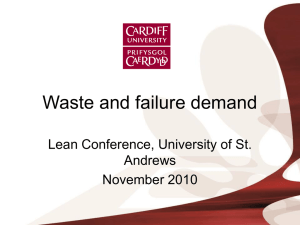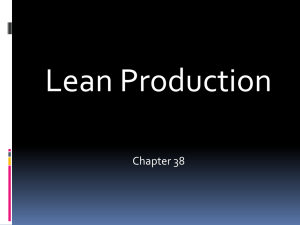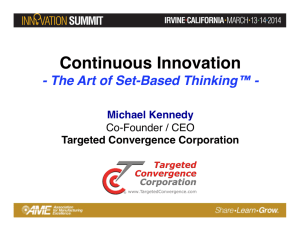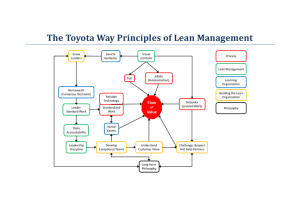Lean Leadership
advertisement
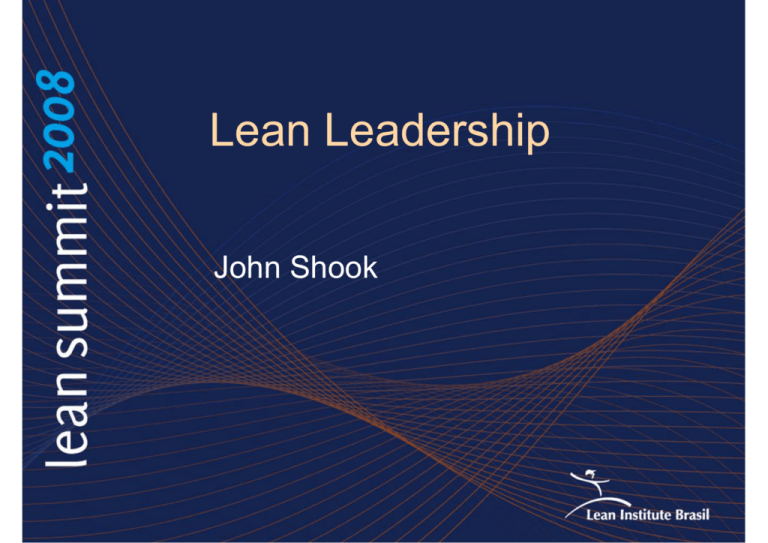
Lean Leadership John Shook 1 Change – the leader’s role… “John, I can’t get my people to do this…” How can you get others to “do this”…? Æ Only one way… 2 3 What is the Role of Leadership? Graphics slide. Place graphic within the white box. 4 Mr. Cho of Toyota: Three Keys to Lean Leadership Go See. • “Sr. Mgmt. must spend time on the plant floor.” Ask Why. • “Use the “Why?” technique daily.” Show Respect. • “Respect your people.” 5 Leadership: Three Models • Old “Dictator” Style: “Do it my way…” • 1970s “Empowerment” Style: “Do it your way... ” • Lean Style: 6 “Follow me… and we’ll figure this out together ” Kan Higashi to Gary Convis… (NUMMI’s senior Japanese and American leaders) “Lead the organization as if you have no power." 7 Toyota Way of Management From managing numbers to managing the process • Leaders at Toyota, like leaders anywhere, want to see measurable results. • But they know that the financial result is a result of a process. • They also realize that the financial result is the result of the past performance of that process. • Far better is to create a process that can be managed right NOW. 8 Toyota Way of Management From the Five Who’s to the Five Whys • Good Toyota leaders don’t jump to conclusions or solutions – they try to first size up the situation and then ask “Why?” • This focuses on the work and problem at hand, avoiding the finger-pointing search for where to place the blame. • It also keeps responsibility (ownership, accountability, authority-as-needed) with the person who is doing the work. • This is what truly engages and empowers the workforce. 9 Toyota Way of Management The “Why? Technique The “Why Technique” is key to management at Toyota. Not only is it used to solve problems (“Why did the machine break down?”) but to dialogue to reach mutual understanding (“Why do you say that?”) and agreement, and also to mentor others (“Why do you think that?”). The usual “Five Why’s” can be reversed: 1. “Why did things go wrong; what is the root cause?” 2. “Why do you propose that?” 10 Toyota Way of Management From Problem-hiding to Problem-solving • All actions at Toyota revolve around planning and problem-solving. • It is assumed that there will be problems, that everything will not go according to plan. • “No problem is problem.” • For the system to work, problems must be exposed and dealt with forthrightly. 11 • Hiding problems will undermine the system. Toyota Way of Management Control with Flexibility • Toyota’s way of managing provides extraordinary focus, direction, “control.” • While at the same time providing maximum flexibility. • This way of working can resolve the ageold dilemma that encumbers all large organizations: control vs. flexibility, or direction vs. adaptability. 12 Innovation and Ownership, Responsibility and Authority • In my five years in Toyota City, almost never was I told exactly what to do or how to do it. • Yet, I was not free to just do what I wanted. • I was given clear responsibility to propose solutions to problems I owned. 13 Leadership at Toyota Responsibility ≠ Authority • Not “bottom-up” or “top-down”. • Processes well-defined and responsibility clear. • From debate about “authority” (territory) to dialogue around “doing the right thing”. 14 Innovation and Ownership, Responsibility and Authority • In a traditional hierarchical organization: • Position establishes (or seems to) authority to make decisions. • -> In cross-functional organizations, this causes confusion, frustration, and breakdown of the decision-making process. • In a Lean Learning Organization: • Position establishes responsibility to get decisions made. 15 Chief Engineer or “Shusa” System Body Eng. 16 Interior Chassis Elect. HR Toyota Way of Management From p-D-p-D to P-D-C-A • Toyota would say this is essentially the P-D-CA management cycle they learned from Dr. Deming. • Probably. Yet this is precisely the thing that most companies can’t seem to do. • Why? • Surely one major reason for this is the way we lead and manage. 17 From p-D-p-D Fire-fighting to P-D-C-A Management Cycle GRASP the SITUATION ADJUST & STANDARDIZE HYPOTHESIS ACTION PLAN REFLECT 18 CHECK STUDY DO TRY Lean Leadership The “Leader as Dictator” of the old days tried to tell everyone what to do. •No transfer, or Cascade of Responsibility The “Leader as Back-Slapper” of the 80s and 90s just set “goals” (MBO) and let everyone do as they pleased. •Loss 19 of focus, direction, control Lean Leadership • The Lean Leader leads a very different way: X…as different from the commonly accepted notion of the “enlightened modern manager” as it is the old command and control dictator. 20 What can we do?? Toyota is Toyota. We can learn from them, but we can’t copy them exactly. How can we operationalize the same principles in our own companies? 21 Impact of Lean Transformation at different organizational levels Role MUST PROVIDE VISION AND INCENTIVE MUST LEAD THE ACTUAL OPERATIONAL CHANGE MUST “DO” Impact SENIOR MANAGEMENT MIDDLE MANAGEMENT Likes the results Left with changed, uncertain role Likes the involvement FRONT LINES A Difficult Struggle at the Mid-management and First Line Supervisory Level 22 Muri: Mura: Muda: overburden variation waste System Design to Control the 3 M’s • Muri – Overburden or unreasonableness to a Too much overtime! person or a machine Stress! Not enough resources! • Mura – Instability; Unevenness; Variability; Inconsistency • Muda – Waste The Seven Types of Waste 23 - End of month deadlines with much overtime followed by periods of not enough work! - All projects scheduled in 1Q with none in 2Q! - Extensive IT everywhere yet not enough copy machines! Basic problem to solve at different levels of the enterprise Role MUST PROVIDE VISION AND INCENTIVE Problem: MURA & MURA Impact SENIOR Likes MANAGEMENT Problem: the results MURA & MURI MUST LEAD THE ACTUAL OPERATIONAL CHANGE MIDDLE MANAGEMENT Wants to be successful Problem: MUDA MUST “DO” Likes the involvement FRONT LINES A Difficult Struggle at the Mid-management and First Line Supervisory Level 24 Muri: Mura: Muda: overburden variation waste PDCA Tools for different levels Role PDCA tool: Policy Management Problem: MURI & MURA Impact MUST PROVIDE VISION SENIOR Likes AND INCENTIVE PDCA tool: MANAGEMENT Problem: VSM or A3 the results MURA & MURI MUST LEAD THE ACTUAL OPERATIONAL CHANGE MIDDLE MANAGEMENT PDCA tool: Standardized Work MUST “DO” Problem: MUDA Needs the right tools and skills to be successful Likes the involvement FRONT LINES Provide the right tool for the right job Muri: Mura: Muda: 25 overburden variation waste Mr. Cho of Toyota: Three Keys to Lean Leadership Go See. • “Sr. Mgmt. must spend time on the plant floor.” Ask Why. • “Use the “Why?” technique daily.” Show Respect. • “Respect your people.” 26 “Go see” “Data is of course important, but I place greater emphasis on facts.” -Taiichi Ohno 27 Core Toyota View: •“You can understand everything that is really important about a company by observing from a good spot on the plant floor.” 28 What to look for - let’s make it easy for ourselves… • Plan vs. Actual • Standardized Work • PDCA – method Visuall y Confirm on the Shop Floor the scientific Tugger Route 29 Mr. Cho “Know normal from abnormal… Best Quality - Lowest Cost - Shortest Lead Time …right now!” J I T” J I D O K A Operational Stability and Kaizen 30 Lean Problem Solving - at the gemba - five whys GEMBA ENGINEER’S ROOM W K OR F A T DA W LO TOOLS DEFECT!! 31 Respect for People Focus on the front line worker XEnable the worker To work safely To know his/her customer To be involved, engaged To be successful XWorker-out or the Front Lines-back principle Build your operating system from the operator out Remove wasteful steps from his work, Giving it to support people: isolate the waste! Until nothing is left but value-creating steps. ÆDon’t waste the operator’s time and effort! 32 Lean Leadership • The Lean Leader leads a very different way: XIt is as different from the commonly accepted notion of the “enlightened modern manager” as it is the old command and control dictator. 33 And what IS “Leadership” anyway?? “The greatest leaders of the 20th century were Hitler, Stalin and Mao: If that is “leadership”, I want nothing to do with it.” - Peter Drucker 34 Lean Leadership Practice of Leadership vs Exercise of Power “I could put a loaded gun to your head…” True leadership exists when people follow when they don’t have to…” (James MacGregor Burns) 35 Eiji Toyoda on Leadership “The people at the top are just flag-wavers. It is pure MUDA to wave your flag and have no one follow you. Waving that flag in a way that makes people fall in line behind you is what is important.” ÆThe Waste of Empty Flag-Waving 36 The leader’s job at Toyota… • First, get each person to take initiative to solve problems and improve his or her job. • Second, ensure that each persons’ job is aligned to provide value for the customer and prosperity for the company. 37 The Leader’s job is to develop his or her people SPIRIT of Lean Mentorship: “If the learner hasn’t learned, the teacher hasn’t taught” 38 Extensive Support and Coaching at the Front Lines of the Organization Foreman Group Leaders Team & Team Leader 39 Lean Leadership • The Lean Leader leads a very different way: XBy setting the vision (more why than how) with nemawashi dialogue, HK planning and setting challenging expectations – at the organizational level – at the individual level XBy building systems and processes that cascade responsibility SW, KB, Stop-the-Line as tools that truly empower HR and HK as broader empowering systems XBy influence and persuasion by example by being knowledgeable by getting into the messy details by coaching and teaching – through PDCA learning cycles – through questioning 40 If “managing” is about thinking... “leading” is about getting other people to think. -- David Verble 41 If improvement is about taking responsibility and initiative Leading is about getting other people to take initiative 42 How do you get other people to think ? and take initiative? 43 Ask them Questions! What Questions? 44 PDCA Questions What: is? is not? should be? might be? must be? GRASP the SITUATION What? How? What? How? ACT PLAN When? Who? Why? What is? CHECK STUDY When? How? DO What is, is not? Why? How? 45 What barriers discourage people from thinking and taking responsibility? 46 What barriers discourage people from thinking and taking responsibility? •You, me or somebody rushes in to give them the answer. •It is more important to give them the right question than the right answer. 47 The A3 Thinking Steps • • • • • • • • • What is the problem? Who owns the problem? What is the root cause of the problem? What are some possible countermeasures? How will you choose which countermeasure to propose? How will you get agreement among everyone concerned? What is your implementation plan? What timetable? How will you know if your countermeasure works? What follow-up issues can you anticipate? What problems may occur during? • How will ensure learning and continuous improvement? 48 Title: What you are talking about Background Why you are talking about it. Current Conditions Where things stand today. Show visually – pareto charts, graphs, drawings, maps, etc. Target/Goal(s) The specific outcome required for the business. Analysis initials Owner Proposed Countermeasure(s) Your proposal to reach the future state, the target condition. How your recommended countermeasures will impact the root cause to change the current situation and achieve the target. Plan A Gantt chart or facsimile that shows actions/outcomes, timeline and responsibilities. May include details on the specific means of implementation. Indicators of performance, of progress. The root cause(s) of the problem. Followup Choose the simplest problem-solving tool for this issue 49 Remaining issues that can be anticipated. Ensure ongoing P-D-C-A. Yokoten as needed. Verble/Shook Title: Create robust process for translating documents Background Recommendations New domestic plant has massive technical requirements that must be translated from Japanese documents. The size and complexity of the project are creating errors and delays. Simplify and improve process performance by choosing one vendor based on competitive bid process. Current Conditions Cost overruns. Delays. Errors. Complexity. Plan Evaluate current vendor. Identify new vendor candidates. Develop bid package, distribute, and choose winning bid. Goal Reduce errors to manageable rate and simplify processes. Reduce cost by 10%. Analysis Challenge of translating from Japanese to English. Complexity and size and amount of documents. Problems stemming from multiple vendors. Followup Monitor cost to proposal. Review performance at end of one-year contract. Put contract up for bid again if performance goals are not met. 50 Title: “Massive”?? How big Recommendations Or important is this problem? Background New domestic plant has massive technical requirements that must be translated from Japanese documents. The size and complexity of the project are creating errors and delays. Simplify and improve process performance by choosing one vendor based on competitive bid process. Current Conditions What does number of vendors have to do with the problem?? Cost overruns. Delays. Errors. Complexity. How much? How many? ??? How long? Goal DP Create robust process for translating documents ??? Plan Evaluate current vendor. Identify new vendor candidates. Develop bid package, distribute, and choose winning bid. Reduce errors to manageable rate and simplify processes. Reduce cost by 10%. Why 10? How can we know any of this will work when We don’t even know the problem or root cause? Analysis Challenge of translating from Japanese to English. Complexity and size and amount of documents. Problems stemming from multiple vendors. Followup Monitor cost to proposal. Review performance at end of one-year contract. Put contract up for bid again if performance goals are not met. What do “challenge and “complexity” mean? What “problems?” What CAUSE??” 51 PDCA Questions • Plan (hypothesis): What and why? No: “What can be done?” Yes: “What needs to be done?” • Plan - Do: When? No: “How fast can we do it?” Yes: “When does it need to be done?” • Check, Reflect: who, why? No: “What did you do?” Yes: “Why did you choose to do what you did?” • Check – Act (Adjust): what, why? Not just: “Did you get the results?” But: “What did you learn?” 52 Lean Leadership •• Traditional Traditional X X “Leadership” “Leadership” as as noun: noun: “leaders “leaders are are born” born” •• Lean Lean X“Leadership” X“Leadership” as as verb: verb: “take “take leadership” leadership” 53 Lean Leadership •• How How do do you you “Take “Take leadership”? leadership”? XBuild XBuild systems systems and and processes, processes, look look for for system/process system/process solutions solutions when when things things go go wrong wrong XTeach, XTeach, or or “Facilitate “Facilitate learning” learning” XInfluence XInfluence right right thinking thinking and and action action 54 Lean Leadership •• How How do do you you “Take “Take leadership”? leadership”? XBuild XBuild systems systems and and processes, processes, look look for for system/process system/process solutions solutions when when things things go go wrong wrong No: No:“My “Myemployee employeedid didthe thewrong wrongthing” thing” Yes: Yes:“What “Whatwent wentwrong wrongwith withmy myprocess?” process?” XTeach, XTeach, or or “Facilitate “Facilitate learning” learning” XInfluence XInfluence right right thinking thinking and and action action 55 Lean Leadership •• How How do do you you “Take “Take leadership”? leadership”? XBuild XBuild systems systems and and processes, processes, look look for for system/process system/process solutions solutions when when things things go go wrong wrong XTeach, XTeach, or or “Facilitate “Facilitate learning” learning” IfIfthe thelearner learner hasn’t hasn’tlearned, learned, the the teacher teacher hasn’t hasn’t taught taught Operations Operationsare areaareflection reflectionof ofmanagement management XInfluence XInfluence right right thinking thinking and and action action 56 Lean Leadership •• How How do do you you “Take “Take leadership”? leadership”? XBuild XBuild systems systems and and processes, processes, look look for for system/process system/process solutions solutions when when things things go go wrong wrong XTeach, XTeach, or or “Facilitate “Facilitate learning” learning” XAim XAim to to influence influence right right actions actions and and thinking thinking Model Modelthe thebehavior behavior(right (rightactions) actions) Look Lookfor forthe thethinking thinkingbehind behindthe theactions actions 57 The Thinking Production System Best Quality - Lowest Cost - Shortest Lead Time Getting people Through Shortening the Production Flow By Eliminating Waste Just in Time “The right part at the right time in the right amount” •Continuous Flow •Pull System •Takt Time Leveled Production to think and Jidoka take initiative “is Built -in Quality the key!” •Automatic Machine Stop •Fixed Position Line Stop •Error Proofing •Visual Control •Labor-Machine Efficiency Production Lines That Stop for Abnormalities Operational Stability and Kaizen Standardized Work Preventative Maintenance; 4S 58 Robust Products and Processes Supplier Involvement Change – the leader’s role… “John, I can’t get my people to do this…” How can you get others to “do this”…? Æ Only one way… 59 Lean Enterprise Transformation Change Culture First (Conventional way) Change System First (Lean Way) Where Do You Start - From Top or Bottom? 60 Lean Enterprise Transformation It’s easier to act your way to a new way of thinking than to think your way to a new way of acting. 61 Sr. Mgmt. System Kaizen Middle Mgmt. Eliminate Muri and Mura Process-step Kaizen Eliminate Muda Front Lines 62 FOCUS
